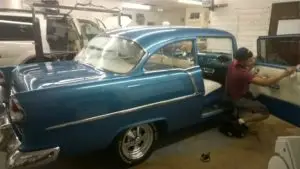What Is Automotive Window Film?
Automotive window tints are ultra-thin laminate films that protect you from the sun’s harsh glare and harmful UV rays. They also help hold shattered glass together in case of a road accident, thus reducing the risk of injury to passengers.
Unlike dye-based and metallic films, nano ceramic technology doesn’t interfere with cell or electronic signals. There is a tint to fit any vehicle, desired look and expected performance.
1. Reduces Glare
Automotive window tint reduces glare, keeping you and your passenger comfortable and safe while driving. This reduces eye fatigue so you can concentrate on the road ahead of you, and it prevents you from blinding others in your vehicle.
can concentrate on the road ahead of you, and it prevents you from blinding others in your vehicle.
Ceramic window tint also blocks a significant amount of solar heat, saving you from cranking up the air conditioning to combat it. It also protects your upholstery from premature fading caused by sunlight and helps keep your vehicle cool while it’s sitting idle. In addition, ceramic film is metal-free so it doesn’t interfere with your electronic devices or cause glare reflections.
2. Blocks Harmful UV Rays
UV rays are the primary cause of skin cancer. Sunlight passes through glass and windshields, but window tint blocks 99% of the harmful UV rays that can damage your skin.
Cancer Council Australia recommends people who spend long periods of time in vehicles use a combination of sun protection measures, such as a long-sleeved shirt with a collar, sunglasses and sunscreen with an SPF 30 or higher, when they are driving. Ceramic car window film is a great addition to these protective measures.
Some window tint also protects your valuables and electronics from the risk of theft by vandals who may be attracted to shiny items in your vehicle.
3. Increases Visibility
Automotive window tint is a specific type of window film. Typically, it’s made from polyester and dyes. While metallic window tint has great glare-reducing capabilities, it can interfere with radio and cell phone signals because of its metal particles.
Ceramic window tint, on the other hand, has no metal particles and provides better glare reduction and UV protection. This is because it’s infused with non-conductive ceramic nanoparticles. This technology also makes it less reflective, resulting in superior performance. It’s also heat formed during installation, allowing installers to shape the film around curves. This helps reduce the risk of heat buildup on glass surfaces.
4. Reduces Heat
Automotive window tint prevents the sun’s infrared (IR) emissions from entering your vehicle and elevating interior temperatures. This reduces your reliance on the air conditioning, protects passengers from potential health issues related to hot temperatures and it prevents costly damage to the vehicle’s interior.
Additionally, when a tempered glass breaks, ceramic film helps hold it together reducing the risk of dangerous shards of glass in the event of an accident. Unlike dyed tints, carbon color stable tints are not affected by sun fading and discoloration. They are also metal-free, allowing for radio wave signal clarity and offering superior heat rejection compared to other films on the market.
5. Enhances Aesthetics
Aesthetically, ceramic tint adds a sense of sophistication to your vehicle. It is a fusion of form and function that looks great, reduces glare, blocks harmful UV rays, and protects your car’s interior.
Automotive window tint is a thin laminate film that can be applied to the windows of automobiles, boats, and buildings. The main material is polyester with dyes or metals added for different effects.
Unlike architectural window film, automotive films are designed to be heat formed during installation, so they can conform to the curves of curved glass surfaces. They also help hold tempered glass together in the event of an accident, reducing the potential for flying shards of glass.
6. Increases Safety
When glass breaks in an accident, ceramic tint helps hold the shards together, reducing the chance of injury to passengers. It also adds a layer of privacy, making it harder for people to see inside your car, which can deter thieves from attempting to break in.
Additionally, unlike dyed tints and metallic films, ceramic window tint does not interfere with radio, GPS or smartphone signals. This means you can drive with confidence, knowing that your vehicle’s technology will work correctly.


One Response